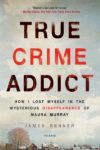Want to know what new media has meant to the true crime genre? Well this weekend brings the first “immersive, weekend-long celebration of all things true crime.” In addition to authors and television personalities, nearly three dozen separate podcasts will be represented. It might even be said that the internet and new media have created a new generation of true crime addicts.
James Renner admits he’s a true crime addict. But his fixation doesn’t stem from media proliferation; it started with his first crush. Renner says he fell in love with Amy Mihaljevic when he saw her missing poster on a utility pole when he was 11 years old. Amy was 10 when she was kidnapped and murdered in a Cleveland suburb in late October 1989. The crime remains unsolved (and a popular podcast subject). After becoming a staff writer for Cleveland Scene magazine, Renner spent two years investigating it in the mid-2000s, something he recounted in his first book in 2006.
Renner takes a similar tack, albeit with a different path, in True Crime Addict: How I Lost Myself in the Mysterious Disappearance of Maura Murray, now out in a trade paper edition. Here, though, Renner isn’t looking around his backyard. He’s looking at a disappearance that occurred hundreds of miles from his home.
 Like many, Renner first heard of Maura Murray on the internet (like Amy Mihaljevic, the case is also a podcast staple). On February 9, 2004, Murray left the University of Massachusetts flagship campus in Amherst, where she was a nursing student. Around 7:30 p.m., she was seen standing by her car, abutting a snowbank and facing the wrong direction on a remote New Hampshire highway. She told a passing bus driver she’d called AAA (although there was no cell phone service in that area) so he needn’t call the police. He did anyway but when authorities arrived a short time later she was gone, never to be seen again. True Crime Addict details Renner’s personal investigation into a curious, if not occasionally convoluted, backstory strewn with rabbit holes. Yet the book differs from more traditional true crime books in two ways.
Like many, Renner first heard of Maura Murray on the internet (like Amy Mihaljevic, the case is also a podcast staple). On February 9, 2004, Murray left the University of Massachusetts flagship campus in Amherst, where she was a nursing student. Around 7:30 p.m., she was seen standing by her car, abutting a snowbank and facing the wrong direction on a remote New Hampshire highway. She told a passing bus driver she’d called AAA (although there was no cell phone service in that area) so he needn’t call the police. He did anyway but when authorities arrived a short time later she was gone, never to be seen again. True Crime Addict details Renner’s personal investigation into a curious, if not occasionally convoluted, backstory strewn with rabbit holes. Yet the book differs from more traditional true crime books in two ways.
Renner employed the tools used by virtually all true crime authors, researching the most pertinent individuals, tracking down and even going door to door to interview persons with knowledge, and obtaining and reviewing relevant documents. But he also took an unusual approach that also reflects the role of new media. Renner advocates what he calls an “open-sourced form of reporting,” where journalists open up their research to anyone interested. He created a blog where he uploaded documents, notes and related material that kept people up to dare and also allowed them to make suggestions and comments and provide information.
The book isn’t clear on the extent to which open-sourcing fostered or burdened Renner’s efforts. It does, however, suggest that it produced at least one previously unknown but potentially significant notion. Whether Renner’s concept is or will become a new journalism tool remains to be seen. It should perhaps be noted, though, that at least one reviewer calls this approach “madness” that produces “a complicated morass of uncontrolled speculation.”
True Crime Addict also differs from traditional true crime books because Renner also some of his own demons, including why he is so drawn to true crime. What is it about a person who looks forward to confronting someone who may be a murderer? Why will a person persistently contact crime victims’ family members and friends when those people have made clear they have no desire to discuss the subject? Is someone like Renner driven by a desire to help or their own curious fixation? Are their actions simply a magnified version of the common compulsion to stare at the accident scene we pass on the highway?
Just as True Crime Addict doesn’t solve the mystery of Maura Murray’s disappearance, Renner’s self-assessment doesn’t — and can’t — answer these questions. In fact, those of us who still trust and rely upon old media (the printed word) may disagree over whether this approach adds a revelatory perspective to true crime cases like Maura Murray’s or is merely self-examination of personal baggage. To the extent the book reflects and is aimed at a culture that increasingly discerns the world through social and new media, my guess is Renner’s personal story, not Maura Murray’s, is the unexplored story.
…there’s a freedom in blind rage once you give yourself over to it that is as welcoming as any drug.
James Renner, True Crime Addict







